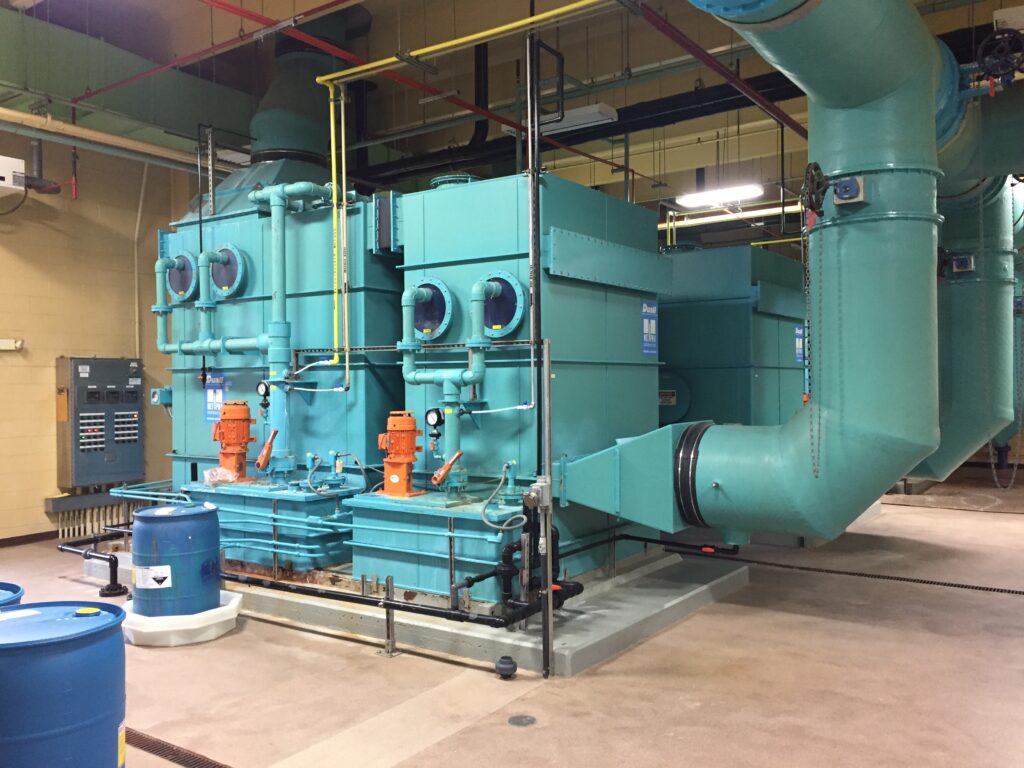Chemical Scrubbers
Chemical scrubbers are a proven odor control technology. The basic objective of a scrubber is to provide contact between the odorous air, water, and chemicals to provide oxidation or absorption of the odorous compounds. The odorous compounds are absorbed into the scrubber liquid, where they are oxidized and/or removed from the scrubber as an overflow or blow-down stream.
The basic components of the scrubber are the vessel; packing material; liquid recirculation system with spray nozzles, recirculation pump, a sump; and a mist eliminator. A fan draws or pushes the odorous air into the scrubber. The air passes through the packing bed where odorous compounds comes in contact and are absorbed into the liquid solution sprayed from nozzles above the packing bed. The liquid solution, after passing through the packing bed, falls into the sump, where it is recirculated or discarded. The air exits the packing bed and is routed through the mist eliminator to prevent liquid droplets from exiting the scrubber.
Typical chemicals used in the liquid solution to oxidize hydrogen sulfide and other reduced sulfur compounds include sodium hypochlorite (bleach) and sodium hydroxide (caustic). The oxidation reactions are dependent on pH, with the optimum scrubber solution pH being in the 9.5 – 10.5 range. In this range, hydrogen sulfide is absorbed into the recirculating liquid. As pH decreases below the optimum range, the hydrogen sulfide solubility decreases and does not absorb into the scrubber solution as effectively. As pH increases above the optimum range, more chemical is used than necessary, and more carbon dioxide is scrubbed from the air stream.
The chemical concentrations are typically automatically controlled by monitoring the liquid solution pH and ORP (Oxidation-Reduction Potential). A pH probe and controller maintain the proper pH by regulating the rate sodium hydroxide is added to the solution. An ORP probe and controller maintain the proper chlorine residual (ORP range of 400-600 mV) by regulating the rate sodium hypochlorite is added to the solution. Make-up water is continuously fed to the scrubber to force out contaminants that accumulate in the sump out the overflow.
Where removal of ammonia and other nitrogen compounds is required, a two-stage scrubber system using a dilute sulfuric acid solution in the first stage is typically used. The ammonia reacts with the sulfuric acid to form ammonium sulfate, a soluble, non-volatile salt, which is removed from the scrubber effluent through the overflow.
Chemical scrubbers can remove up to 99.5% of hydrogen sulfide and ammonia, even at high concentrations. They require a relatively small footprint, but require significant operational and maintenance attention, chemical handling and storage, and disposal of scrubber effluent wastewater. Due to the special handling requirements of the chemicals involved, extensive training of operators of these systems is required. They are not considered to be effective for removal of volatile organic compounds (VOC’s) or some or the more odorous reduced sulfur compounds like dimethyl disulfide.
Applicable Treatment Processes
All liquid treatment plant processes, pump stations, sludge thickening, sludge dewatering.
Major Design Considerations
Contaminants to be removed
Chemical treatment selection is based on contaminants to be removed. Hydrogen sulfide may be treated using a solution of sodium hypochlorite and sodium hydroxide. Ammonia may be treated using a dilute solution of sulfuric acid. VOC’s are not effectively treated in wet chemical scrubber systems.
Number of stages required
A multiple stage scrubber system may be required for removal of multiple contaminants such as hydrogen sulfide and ammonia. Multiple stages may also be used for treatment of very high contaminant concentrations. Two and three stage systems are common.
Liquid solution controls
The liquid solution must be properly monitored and controlled to ensure proper pH and ORP levels are maintained in the scrubber solution for efficient operation. Liquid levels must also be monitored and controlled.
Packing material
Packing should possess high surface area to volume ratio and possess shapes and sizes to provide a tortuous path for adequate detention time, while minimizing pressure drop. Materials vary dependent on contaminants being treated and the temperature of the air.

